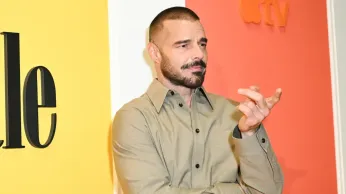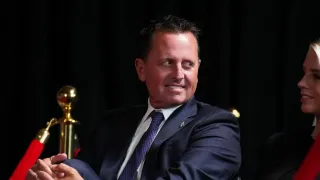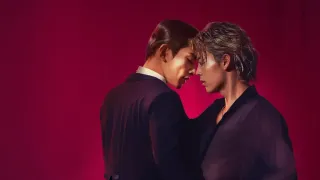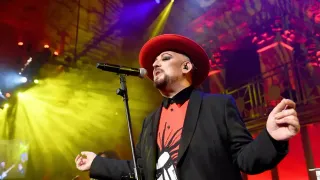
Nov 13
Ricky Martin Turns Up the Heat in Palm Royale: Queer Sensibilities and Steamy High Society
READ TIME: 4 MIN.
It’s official: Palm Royale is back, and Ricky Martin is promising the kind of heat that only a queer icon can deliver. As Apple TV’s period comedy dives deeper into the secrets and scandals swirling around Palm Beach’s elite, Martin’s character, Robert, is poised to set screens ablaze with more “nudity” and “kissing”—a playful promise that’s already sending ripples through the LGBTQ+ community and beyond .
Martin, who’s been vocal about embracing queer roles and pushing for authentic representation, told Out in a recent interview, “I am ready for whatever comes… There’s a lot of nudity and a lot of kissing. What can I say? I’m just happy to be here” . For queer viewers, that’s more than a tease—it’s a declaration that Palm Royale is making space for us, our stories, and the kind of onscreen intimacy too often shied away from in mainstream entertainment.
The show’s premise—a scrappy underdog clawing her way into the glitzy, exclusive world of Palm Beach’s socialites—already has queer resonance. Palm Royale is, at its heart, a story about outsiders longing to belong, fighting for a seat at the table, and refusing to play by the rules of a world built to exclude them . Kristen Wiig’s Maxine is a woman on the margins, and Ricky Martin’s Robert—her confidant and sometimes co-conspirator—radiates the kind of campy charisma that only a queer performer can bring.
Palm Royale is set in 1969, a time when queer visibility was virtually nonexistent in the mainstream, especially in places as stifling as Palm Beach high society. The show’s aesthetic—opulent costumes, sharp dialogue, and a sly wink at the hypocrisy of the upper crust—makes it a decadent playground for queer storytelling. It’s no accident that its creator, Abe Sylvia, is known for bringing LGBTQ+ themes into the spotlight .
Ricky Martin’s journey from closeted superstar to out-and-proud actor is one that resonates deeply with LGBTQ+ audiences. His willingness to bring queer intimacy to the screen—without apology, without censorship—feels both radical and necessary. In Palm Royale, Martin’s role isn’t just about eye candy. It’s about inhabiting a space that has historically excluded queer people and challenging the notion that only straight stories deserve to be told in lush, high-budget dramas .
When Martin teases “a lot of nudity and a lot of kissing,” he’s not just promising titillation. He’s gesturing toward a future where queer desire is visible, celebrated, and treated with the same glamour as its straight counterparts. For Latinx queer viewers, seeing a global superstar like Martin go all-in on a role with queer undertones is a powerful affirmation: you belong in these spaces, and your stories matter.
Palm Royale is more than just a frothy period comedy. It’s a lens on class, gender, and sexuality—wrapped in pastel silk and delivered with a wink. The show asks, “How much of yourself are you willing to sacrifice to get what someone else has?”—a question that hits home for anyone who’s ever felt like an outsider in their own community .
The buzz around more “nudity” and “kissing” isn’t just about spicing up the drama. It’s about normalizing queer intimacy, making it part of the fabric of mainstream storytelling. In a world where queer representation still feels precarious, Palm Royale’s playful, unapologetic embrace of desire is refreshing, affirming, and deeply necessary.
The show’s cast—anchored by Wiig’s comedic brilliance and Martin’s sultry charm—is a testament to the power of diverse talent. Palm Royale doesn’t just include queer characters; it puts them front and center, giving them agency, wit, and the kind of complexity that’s often reserved for straight leads .
For LGBTQ+ viewers, watching Palm Royale is a reminder that our stories are worth telling, our desires are worth celebrating, and our joy is worth seeing in technicolor. Ricky Martin’s performance is a masterclass in queer charisma—a blend of vulnerability, mischief, and palpable desire. The promise of more steamy scenes is exciting, but it’s the emotional depth that lingers: the sense that, even in the most exclusive circles, outsiders can find family, love, and liberation.
Palm Royale’s high-society setting may be worlds away from most of us, but its heart—outsiders seeking belonging—feels profoundly queer. The show’s willingness to lean into camp, complexity, and unfiltered desire makes it a beacon for anyone who’s ever felt like they had to jump the back wall just to get a glimpse of the party .
With each new season, Palm Royale is cementing itself as a queer cultural touchstone—a show that’s as fun as it is meaningful. Ricky Martin’s teasing of “nudity” and “kissing” isn’t just a marketing ploy. It’s a promise: queer stories are here to stay, and they deserve every ounce of glamour, drama, and affection the screen can offer.
As Palm Royale continues to push boundaries, queer viewers can count on seeing themselves not just in the margins, but at the center of the story. And if Ricky Martin has anything to say about it, there will be plenty of steamy moments to savor along the way.






